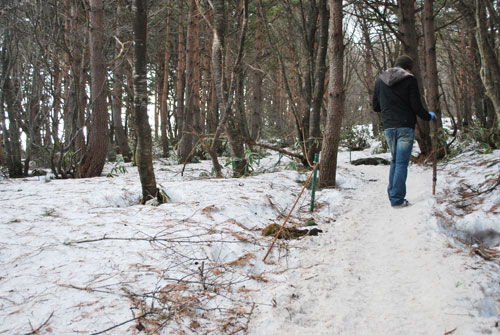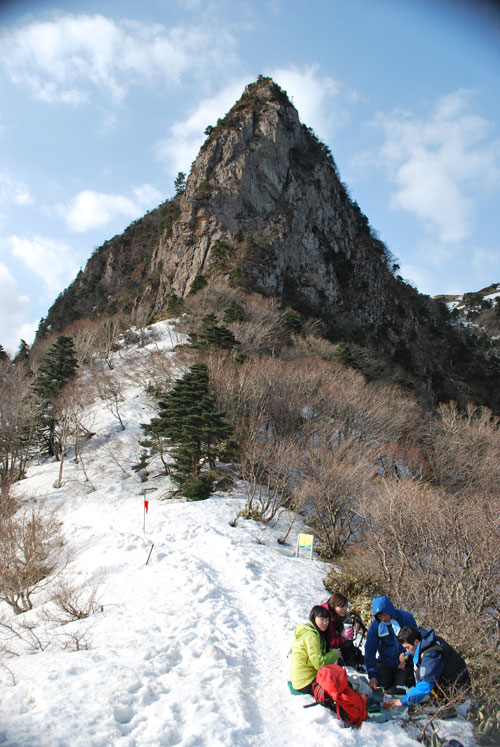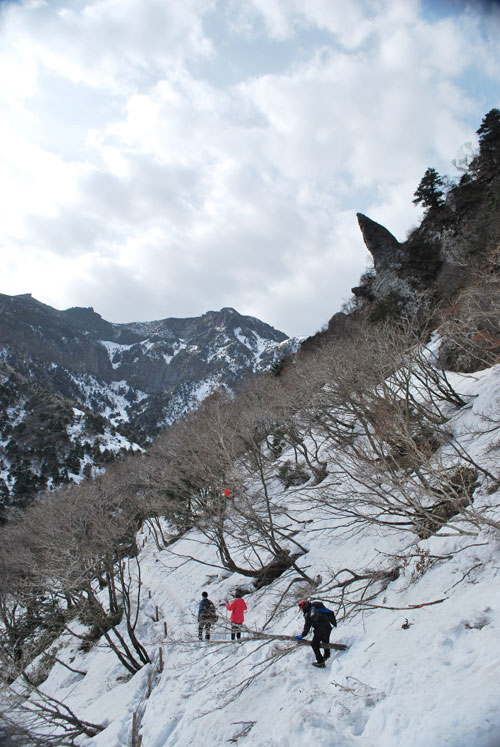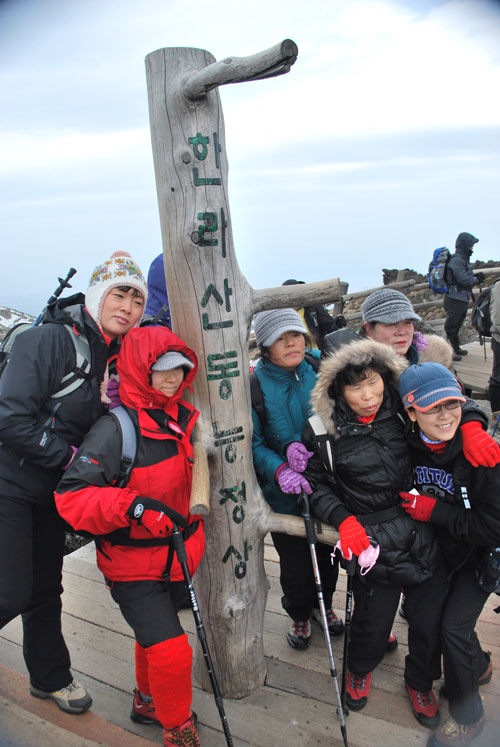 Snowy trails leading up Mt. Halla.
Snowy trails leading up Mt. Halla.
South Korea is covered in mountains, so it’s always seemed odd to me that the nation’s highest point isn’t on the peninsula, but on Jeju Island. But the 1,950-meter Mount Halla, or Hallasan (한라산), as it’s known in Korean, is indeed South Korea’s rooftop.
The locals say that Jeju and Hallasan are essentially one and the same. And from the vantage point of my incoming flight, I could see why. The entire island looked like one giant volcano, with Hallasan’s gentle slopes advancing from its peak down into the sea.
 Most of the mountain trails are flanked by an attractive low-growing bamboo.
Most of the mountain trails are flanked by an attractive low-growing bamboo.
The previous night my friend and I had stayed up late enjoying the Daeboreum Fire Festival. But that didn’t mean we could sleep in. Our itinerary had us climbing Mount Halla, and besides hoping to beat the crowds, we were under time constraints. To ensure hikers can safely descend before nightfall, the final two kilometers of the nearly 10-K icy slog to the summit closes at noon.
 Looks like a ramyeon pit stop before the final push to the peak!
Looks like a ramyeon pit stop before the final push to the peak!
Although there are five trails, currently only two access the summit. The eastern Seongpanak (성판악) route is longer, less arduous and has more traffic. The northern Gwaneum Temple (관음사) trail is less popular, but more difficult. Feeling up to the task, we opted for the latter.
At dawn we were underway, and for the first stretch, the trail followed an impressive, though mostly dry streambed. As the light permeated the leaf-less canopy of branches, I noticed an attractive bamboo groundcover I don’t recall seeing on any other Korean mountain.
 Hallasan’s high altitude eastern slopes bear the brunt of high winds.
Hallasan’s high altitude eastern slopes bear the brunt of high winds.
But about an hour and a half into our hike there was snow underfoot, and 15 minutes later, we were slipping and sliding. Unlike typical Korean hikers in their fluorescent Gore-Tex gear and supplies worthy of a Mt. Everest expedition, we didn’t have hiking poles or ice-climbing boots. The icy path was narrow and steep and, to make things worse, my messenger-style backpack filled with our provisions hung awkwardly off my lower back. But thankfully we had picked up some spiked bands for our tennis shoes, and they came in handy over the next several hours.
 A narrow and icy trail exacerbated by felled trees.
A narrow and icy trail exacerbated by felled trees.
This was especially true when we started confronting a steady stream of fellow hikers. These early birds had taken the northern trail and were now on their way down. The trail wasn’t wide enough to accommodate two lanes of traffic and neither side was eager to yield to let the other pass.
But about two kilometers from the top we came upon a wonderful oasis. A small building served what tasted like the world’s most delicious instant noodles. The soup and some gimbap gave us energy for our final ascent. Our spirits buoyed, the final leg was spectacular.
 A little bit of company at the top.
A little bit of company at the top.
We could see the hundreds of little secondary volcanoes that dot Jeju’s landscape. Further, Jeju City hugged the island’s rugged coastline. In our immediate vicinity were the white trunks of stunted and dead fir trees, killed by the cold and wind. Acres of just exposed lava rock and snow made a nice contrast of white on black. Minutes later, we had reached the top. The summit featured a familiar site in hiking-crazy Korea: hundreds of smiling climbers snapping photos.
 Hallasan’s summit crater boasts one of Korea’s only natural lakes.
Hallasan’s summit crater boasts one of Korea’s only natural lakes.
At Hallasan’s tip is a massive crater with a circumference of 1.7-kilometers that is over 100 meters deep. Its name, Baengnokdam (백록담) comes from a legend that mountain gods once played there with roe deer, more than 1,000 of which are said to still inhabit the crater and elsewhere on Hallasan. Featuring a shallow lake, it’s designated one of Jeju’s 10 scenic wonders.
 This group of Korean ladies has conquered South Korea’s highest climb.
This group of Korean ladies has conquered South Korea’s highest climb.
So, we had done it! Sure, it would be another four hours before we returned to the bottom but South Korea’s highest point had been conquered.
Getting There:
→ From Seoul’s Gimpo International Airport, dozens of flights depart for Jeju City daily.
The 1-hour flight costs between 167,000-244,000 won ($113-$165) on major Korean carriers, and around 108,000 won ($73) on budget carriers, like Jeju Air. Once on Jeju, reach the Gwaneum Temple trail by taking road 1131 until you verge right on 1117. If you want to descend via the Seongpanak eastern route, simply grab a taxi at the bottom to return to your car (about 15,000 won), or back to town.
Learn More:
→ Jeju Special Self-Governing Province (official site)
→ Korea in the Clouds’ Mt. Halla information
(A version of this text aired on KBS World Radio on February 28, 2009.)



Hi Matt,
I’m enjoying your multi-part report on Jeju. I couldn’t believe that you made snowy hike up Halla Mountain in sneakers! My feet got cold just listening to you talk about it! I feel like I should box up a pair of Gortex hiking boots and send them out to you.
I think it’s interesting that, even here in the States, you can see evidence of Korean’s love of hiking. Just about every time I’ve hiked Sugarloaf Mountain (a fairly popular private park out here) I see groups of Koreans on the trails.
Talk to you later, and keep up the great work!
Jeff
By: Jeff Bolognese on 5 March 2009
at 22:12
Hey Jeff,
It’s great to hear from you. I hear from Abby you’ve been busy lately. I hope your kids are doing well.
Yes, we were ill-prepared, but didn’t suffer too much… although I strongly suggest ankle support to future climbers!
Anyhow, thanks again for checking in, and I hope to hear from you again, soon.
Best,
Matt
By: Matt Kelley on 11 March 2009
at 23:18
[…] Baekdusan Mountain on North Korea’s border with China to Mount Hallasan on Jeju island, the Korea is home to thousands of magnificent peaks. But while some of the […]
By: Wolchulsan Mountain « Discovering Korea on 29 April 2009
at 12:32
[…] was discussed here on an earlier post about climbing Jeju’s Mt. Hallasan,volcanoes because they are a very important part of Jeju’s history. In addition to Mt. Halla are […]
By: Jeju’s Sunrise Peak « Discovering Korea on 4 May 2009
at 00:04
We are traveling around Jeju now in late October. I am wondering what foot gear we need to make the climb up this volcano at least 80% up. We did not bring heavy boots since we have been driving around Korea for three weeks and we try to travel as light as possible, and Jeju winds up our trip.If anyone has comments please email me. Thank you.
By: Bill on 22 October 2012
at 12:44